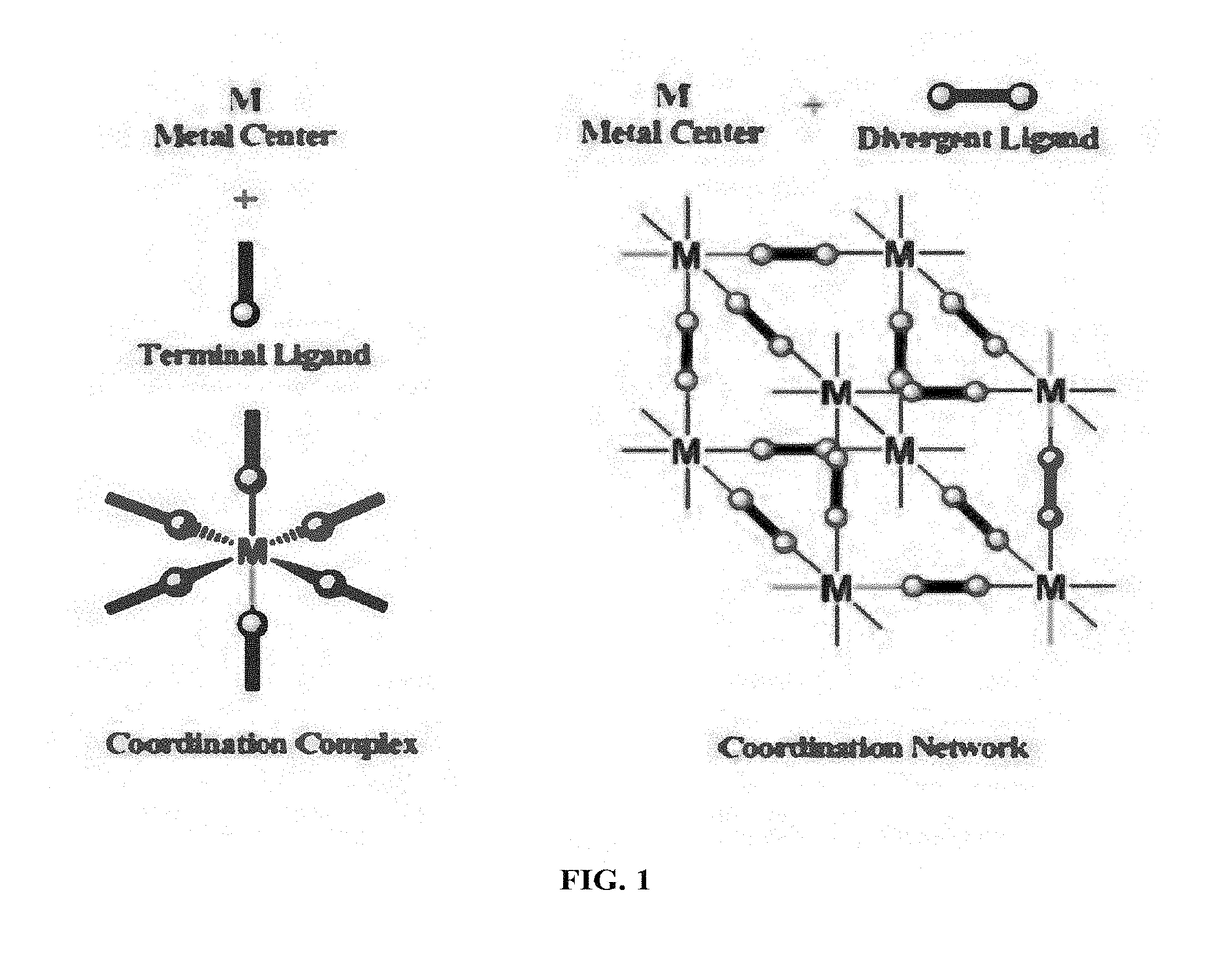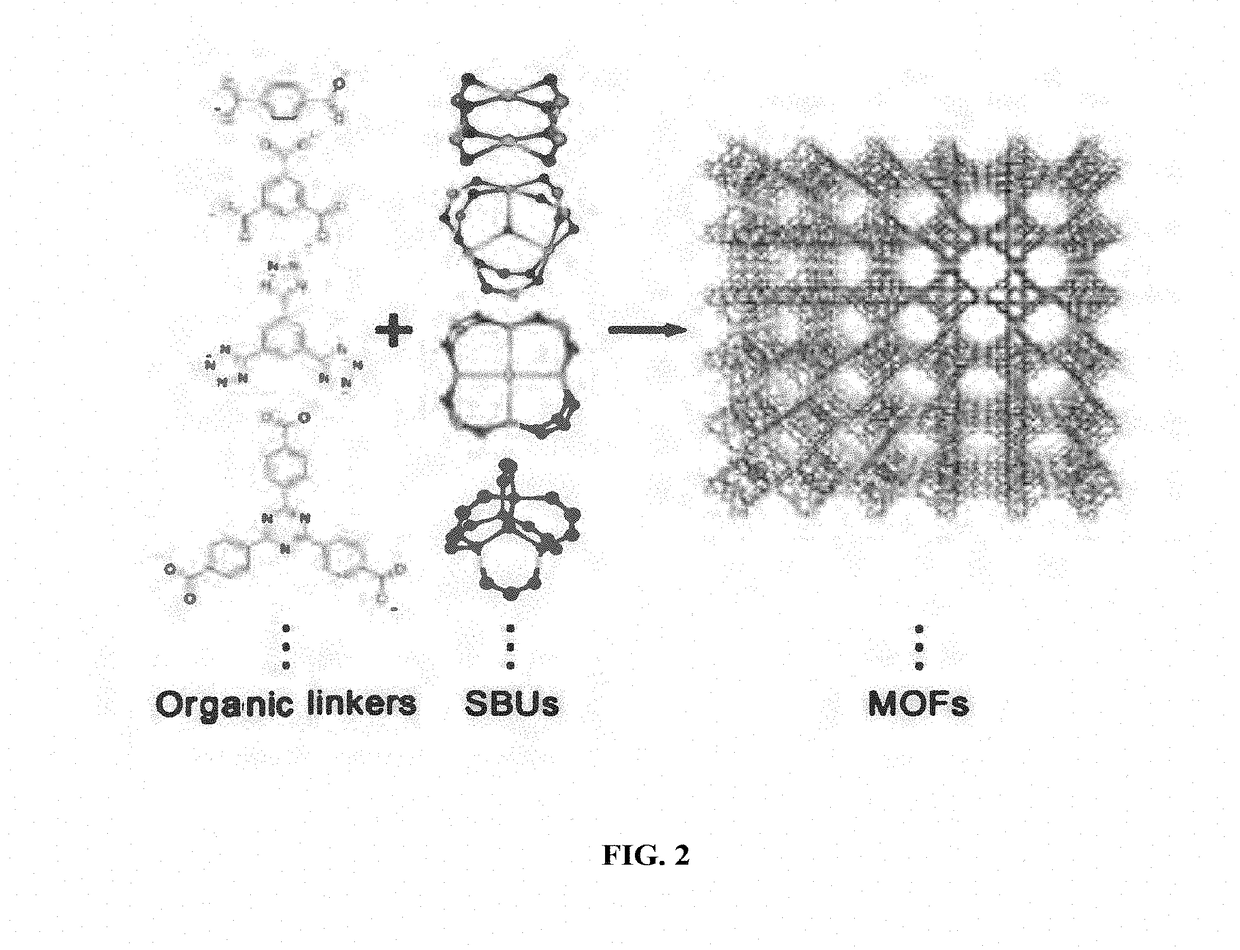Metal organic frameworks as catalysts and hydrocarbon oxidation methods thereof
- Summary
- Abstract
- Description
- Claims
- Application Information
AI Technical Summary
Benefits of technology
Problems solved by technology
Method used
Image
Examples
example 1
Chemicals and Materials
[0158]All reagents were used as purchased without further purification. 1,3,5-benzene tricarboxylic acid (BTC), Cu(NO3)2 3H2O, Co(NO3)2 6H2O, Ni(NO3)2.6H2O, Zn(NO3)2.6H2O, FeCl2-6H2O, N,N-dimethylformamide (DMF) and ethanol were obtained from Sigma-Aldrich. Acetonitrile was obtained from Sigma-Aldrich. Toluene, cyclohexane and methylcyclohexane were used as purchased from Sigma-Aldrich. New 10 mL and 20 mL kimble scintillation vials were used for the synthesis of various metal organic frameworks (MOFs).
example 2
Synthesis of Metal Organic Frameworks (HKUST-1 and Zn-HKUST-1) and Transmetallation of ZN-HKUST-1
[0159]In a standard procedure, a mixture of Cu(NO3)2.3H2O (0.438 g, 1.81 mmol) and 1,3,5-benzenetricarboxylic acid (BTC) (0.236 g, 1.12 mmol) were completely dissolved in a solvent mixture containing N,N-dimethylformamide (2 mL), deionized water (2 mL) and ethanol (2 mL) in a tightly sealed 20 mL vial [Rowsell, J. L. C. & Yaghi, O. M J. Am. Chem. Soc., 2006, 128, 1304-1315.—incorporated herein by reference in its entirety]. The tightly covered vial was placed in an isothermal oven at 85° C. for 20 hours to yield small, blue, octahedral crystals. After cooling the vial to room temperature, the mother liquor was decanted and the tiny crystals were rinsed with DMF three times. The crystals were then activated by soaking in 5 mL of dichloromethane (DCM) for 3 days at room temperature during which DCM was decanted and freshly replenished three times. The crystals were dried under vacuum at 16...
example 3
Fourier Transform Infrared (FT-IR) Spectroscopy Analysis of Prepared Metal Organic Frameworks (MOFs)
[0163]Fourier transform infrared (FT-IR) spectra were taken on a Nicolet spectrophotometer using KBr within the standard range of 400-4000 cm−1. This method was used to confirm the formation of HKUST-1, Zn-HKUST-1, as well as the transmetallated Zn-HKUST-1 isostructural metal organic frameworks (MOFs). 1,3,5-benzenetricarboxylic acid (BTC) as a ligand shows the C═O stretching frequency of carboxylic acid around 1718 cm−1 and also a broad O—H peak at about 2933 cm−1 which corresponds to the hydrogen bonding. FIG. 13 is the FT-IR spectrum of 1,3,5-benzentricarboxylic acid (BTC). The FT-IR analysis of HKUST-1 (FIG. 14) and Zn-HKUST-1 (FIG. 15) indicates that there was a significant shift in the C═O stretching frequency of the BTC ligand. The disappearance of the broad acidic O-H peak of BTC at 2933 cm−1 was the result of deprotonation that leads to coordination. The band for the O—C—O as...
PUM
| Property | Measurement | Unit |
|---|---|---|
| Temperature | aaaaa | aaaaa |
| Temperature | aaaaa | aaaaa |
| Length | aaaaa | aaaaa |
Abstract
Description
Claims
Application Information
 Login to View More
Login to View More - R&D Engineer
- R&D Manager
- IP Professional
- Industry Leading Data Capabilities
- Powerful AI technology
- Patent DNA Extraction
Browse by: Latest US Patents, China's latest patents, Technical Efficacy Thesaurus, Application Domain, Technology Topic, Popular Technical Reports.
© 2024 PatSnap. All rights reserved.Legal|Privacy policy|Modern Slavery Act Transparency Statement|Sitemap|About US| Contact US: help@patsnap.com










